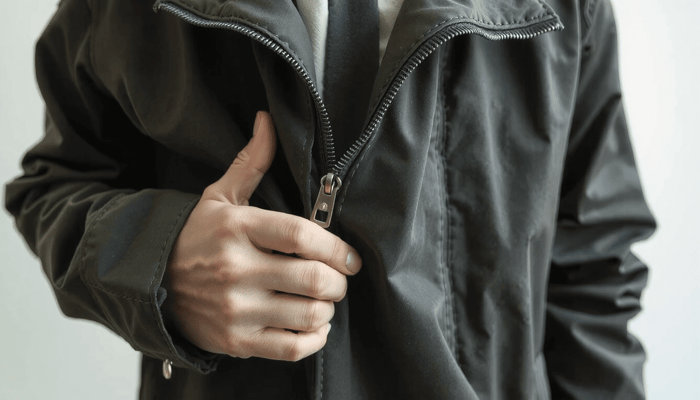Your Complete DIY Guide to Fixing a Jacket Zipper: From Getting Stuck to Replacing It
 Mr. Eton Yip | 32+ Year Garment Manufacturing Expert & Founder of Eton Garment
Garment Industry
Mr. Eton Yip | 32+ Year Garment Manufacturing Expert & Founder of Eton Garment
Garment Industry
July 22nd, 2025
11 minute read
Table of Contents
A malfunctioning zipper on your go-to jacket is a common cause of irritation. Such issues are common. But don't rush to either throw the jacket away or pay a high repair fee. It's likely that you can repair it yourself. A faulty zipper doesn't signify that your jacket is doomed.
The solution could be simpler than you assume. Generally, all you would require is a pair of pliers and a few spare minutes. On some occasions, a part will need to be exchanged. This guide demonstrates everything you need to know about how to repair a jacket zipper, including the required materials and tools. We'll discuss quick fixes for stuck zippers and full replacements. We've got you covered.

Step One: Finding Out the Problem
Before we go on to fix the zipper, we have to diagnose what's the issue. Several types of issues should have various symptoms. Getting the correct diagnosis at the beginning will be sure to help you save your time and energy.
Use this table to identify what you see, the possible causes, and the solutions. This is your first step in the journey of discovering how to repair a jacket zipper.
| The Symptom (What you're seeing) | The Likely Problem | Your Solution (Jump to Section...) |
|---|---|---|
| Zipper is stuck and won't move at all. | A thread is obstructing the teeth or lack of lubrication. | See Section: The Quick Fixes |
| Zipper is closed but after that, it separates or splits behind the slider. | The slider is worn out, loose, or has widened over time. | See Section: The Quick Fixes |
| The pull tab has snapped but the main slider body is still on the track. | The pull tab, a small moving part, has broken. | See Section: The Quick Fixes |
| The slider has come off either one or both sides of the zipper track. | The bottom stop is broken, or the slider is off-track. | See Section: How to Replace a Broken Zipper Slider |
| There are visible broken or missing teeth on the zipper tape. | The zipper teeth or the tape itself are permanently damaged. | See Section: How to Replace the Entire Jacket Zipper |
The Quick Fixes for Common Problems
A lot of zipper issues can be solved in no time at all with things you have in your home. These are the easiest of the short wins that will enable your jacket to function properly within minutes.
Fixing a Stuck Zipper
- Inspect meticulously the zipper teeth surrounding the slider. Usually, a thread or a bit of fabric gets stuck inside. Use tweezers to help you pull out whatever is stuck there.
- In case the track is clear, the difficulty lies in friction. Take a pencil and rub graphite on the zipper teeth on both sides of the stuck slider. Graphite is an excellent dry lubricant. You can also use soap or wax paper.
- Gently toggle the zipper pull up and down. You should experience the lubricant working as it begins to loosen. Be patient and do not force it. There are many excellent resources with more ideas on fixing a separated or stuck zipper.
Fixing a Zipper That Splits
This occurs due to the widening of the slider from use. It no longer presses the zipper teeth together closely enough to work. This is a straightforward mechanical adjustment.
- Move the slider to the bottom of the jacket.
- Use needle-nose pliers. Squeeze the top and bottom parts of the slider together. Just apply a little bit of pressure. Focus on the end of the slider that goes over the joined teeth.
- Pull the zipper by an inch or two to test it. If it still splits, try again with a bit more pressure. However, be careful not to squeeze too hard; otherwise you can jam or break the slider. This temporary fix can prolong the life of your jacket.
Making a Temporary Zipper Pull
Should the pull tab break off and the slider body is OK, you have a quick solution. You just need something that goes through the small hole on the slider to give you leverage.

A paperclip is a great fit. You can also use a key ring for something more permanent and strong. A small loop made up of a strong cord, paracord, or leather shoelace also works well and looks custom.
Intermediate Repair: Replace the Slider
In the case where squeezing with pliers didn't help to solve your splitting zipper, or if the slider fell off completely, then it's time to replace the slider. This is the most common real repair and a wonderful skill to have. It's useful to know the different zipper parts like sliders and stops before you begin.
Tools and Materials You'll Need
- A new zipper slider (make sure it's the right size and type)
- Needle-nose pliers
- End nippers or small wire cutters
- A new zipper top stop (often comes with a new slider)
Step-by-Step Slider Replacement
- Remove the Top Stop: Look at the top of the zipper on one side. You'll see a small metal or plastic piece crimped onto the end of the zipper tape. This is the top stop. Use your pliers or nippers to carefully pry it off. Work slowly to avoid damaging the fabric tape.
- Slide the Old Slider Off: With the stop gone, your path is clear. Simply pull the old, broken slider up and off the zipper track.
- Thread the New Slider On: Take your new slider. Make sure it faces the right way up. Carefully guide the zipper tape teeth into the top of the slider. It's better to start with the side that still has its bottom pin and box.
- Engage Both Sides: This is the hardest part. Line up the two sides of the zipper tape so they're even. Feed the second side of the zipper teeth into the other opening at the top of the slider. Wiggle it gently until you can feel both sides engage.
- Test the New Slider: Before you finish, zip the slider up and down the track a few times. Make sure it joins the teeth perfectly and doesn't split.
- Install a New Top Stop: Once you see the new slider is effective, you have to install a new top stop. Place the new metal stop where the old one was and use your pliers to crimp it firmly in place. This will prevent the slider from coming off at the top.
Advanced Repair: Replace the Entire Zipper

At times, the problem isn't the slider. It's the teeth themselves. If you have missing or broken teeth, or if the fabric tape is torn, a full replacement is your only option. This requires more learning and basic sewing skills.
When is a Full Replacement Necessary?
You will need a full replacement when you see gaps where teeth used to be. Also if the plastic teeth have snapped, or the fabric tape of the zipper has been ripped away from the jacket. These problems are not fixable.
The Process Overview
- Gather Supplies: You will need a seam ripper, a new zipper of the right length and type (coil, molded plastic, metal), pins, and either a sewing machine or a heavy-duty needle and strong thread.
- Remove the Old Zipper: Using the seam ripper, carefully cut and remove the stitches holding the old zipper in place. Work slowly so you won’t damage the fabric.
- Pin the New Zipper: With the new zipper unzipped, pin one half to the jacket. Carefully line it up where the old one was, using the original stitch line as your guide.
- Sew the First Side: Using your sewing machine or by hand, sew the first side of the zipper onto the jacket.
- Align and Pin the Second Side: This step is critical for alignment. Zip up the side you just sewed. Now pin the loose half of the zipper to the other side of the jacket. This ensures the jacket will close evenly without bunching or being misaligned.
- Sew the Second Side: Unzip the zipper again and sew the final side in place. For a more detailed walkthrough, we recommend this no-unravel method for replacing a whole zipper from iFixit.
Know Your Limits: DIY vs. A Professional
The skill to mend a jacket zipper is very useful. However, it is equally essential to know when the task must be given to a professional tailor.
Consider a Professional Tailor If:

- The jacket is an expensive item, made of a difficult material like leather or suede, or it is technical outerwear with waterproof seams.
- The zipper is a specialized waterproof or airtight type, which requires special equipment to install correctly.
- The fabric around the zipper is delicate, torn, or badly frayed from the initial damage.
- You are not comfortable with sewing, especially for a full replacement where alignment is key.
- The repair is simply a task you don't have time or patience for. There's no shame in outsourcing!
Ultimately, a jacket's durability often comes down to its initial construction. High-quality garments use strong components to prevent these issues from happening in the first place. For those sourcing or designing apparel, understanding the importance of quality zippers and expert assembly is key. This is a principle we prioritize in all our custom garment manufacturing. You can learn more about our commitment to quality at Eton Garment.
An Ounce of Prevention: Keeping Zippers Healthy
Preventing the zipper from breaking at the outset is the smartest fix. A little maintenance goes a long way.
Simple Maintenance Tips
- Keep it Clean: Regularly use a small, stiff brush and some soapy water to clean dirt, sand, and grit from the zipper teeth.
- Lubricate: Especially on heavy-duty jackets, occasional lubrication is key. Use a zipper-specific lubricant or a clear silicone spray.
- Be Gentle: Do not ever force a stuck zipper. Always investigate what caused the snag before you yank on the pull.
- Closing the Jacket: Before zipping up, always ensure that the insertion pin is fully and securely seated in the slider box at the bottom. Most breaks happen from zipping up with an improperly engaged base.
Frequently Asked Questions (FAQ)
Can I use WD-40 on my jacket zipper?
Although it can function as a lubricant in desperate times, we do not advocate its use. WD-40 is oil-based and can attract more dirt over time. It might also leave a stain on the jacket fabric. A silicone spray, zipper wax, or a simple graphite pencil would be way better and safer.
How do I know what size zipper slider to buy?
Look at the back of your original slider. There's almost always a number stamped on it (like 3, 5, 8, 10) and sometimes letters showing the type (like VS, CN). This is the size and type you need to match. If it's unreadable, you can measure the width of the closed zipper teeth in millimeters. That number is generally the zipper size.
My plastic zipper teeth are broken. Can they be fixed?
Sadly, individual broken or missing plastic teeth can't be repaired. A single broken tooth compromises the entire chain. In this case, your only option is to replace the entire zipper assembly.
Why does my jacket zipper keep getting stuck in the same spot?
This usually happens for one of two reasons. Either there's a frayed thread from the jacket's seam that keeps getting caught, or there's a slightly bent metal tooth in that area. Examine the spot thoroughly and use tiny scissors to cut off any frayed threads. If it's a metal zipper, you can use pliers to gently straighten any tooth that looks out of place.
Is it expensive to have a tailor replace a jacket zipper?
The cost varies based on your location, the complexity of the jacket (for example, if it has a lining or storm flaps), and the cost of the replacement zipper itself. However, it tends to be a very inexpensive repair. For a quality jacket that you truly adore, the cost is almost always far less than buying a new one. This makes it a very worthwhile investment.
Related Articles
A Barbour Jacket Is a Definitive British Element! The Complete Guide to This Icon
10 minute read
July 22nd, 2025
A Barbour jacket symbolizes the British identity. It is precisely made as it is outerwear made... more »
The Ultimate Guide: How to Get a Jacket That Fits You Best
11 minute read
July 22nd, 2025
Shopping for a jacket online should be a fun, not a risky thing to do. We've all had that horrible... more »
Today's Jacket Dilemma: How to Make the Right Choice
5 minute read
July 22nd, 2025
Every day we wake up and face the same scenario. Check out the weather. Look at the closet. Ask... more »
What is a Bomber Jacket? The Ultimate Guide to Fashion's Classic Piece
9 minute read
July 22nd, 2025
A bomber jacket is a short, waist-length outerwear piece. It has a zipper in the front, a defined... more »

The Definitive Biker Jacket Style Manual: Pairing Suggestions for Every Individual and Tradition
10 minute read
July 23rd, 2025
The Biker Jacket's Alluring Charm Through the AgesAn authentic leather biker jacket is not merely a... more »

